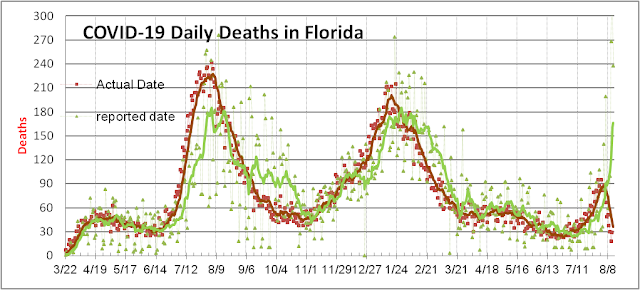COVID-19 Testing in the US Still has Issues
Two weeks ago we posted a commentary about the importance of quick, accurate and thorough testing in the war
against COVID-19 and suggested that after an abysmal start the US was finally on
the right track. We are less optimistic
now - particularly after reading about the President's recent appeal to the South
Korean government for 600,000 test kits.
What is the problem with the much-touted US COVID-19 testing program?
The figure above shows that after a slow start in February
and through early March, cumulative testing (blue circles) accelerated exponentially
from early to late March when its growth slowed again. Since April 9th when daily tests
peaked (brown squares against left axis in the figure below) at 163,172 completed
tests, testing has steadily declined to 129,854, yesterday. This is highly concerning since the President
and some governors have promoted the accessibility, speed, and accuracy of US
COVID-19 testing for many weeks. Moreover,
if US testing has hit another bottleneck due to lack of testing personnel, equipment
and/or supplies, some of the recent declines in daily confirmed case count may
be artificially hiding an underlying increase in real daily COVID-19
cases.
To check this possibility we looked at the percentage of
tests that are returned positive (blue diamonds in the figure above plotted
against the right axis) over the last six weeks. Back in early March testing
was definitely constrained and on several days the percentage of positive
results approached 20%. Then as the US
ramped up testing by permitting commercial labs to run these tests and removing
the CDC as the bottleneck, the percentage of positive test results fell below
10% for many days near mid-March indicating that we were beginning to test many
weakly symptomatic or asymptomatic cases.
However since then the percent positive has climbed back to 20% in early
April and stayed above 1 out of every 6 tests.
Compared to best in class countries such as Taiwan (1in 118), South
Korea (1 in 49), and Singapore (1 in 25) this is still abysmal performance.
Compared with good European nations such as Norway (1 in 19), Germany (1 in 10)
and Austria (1 in 10) our record is still bad. As we mentioned yesterday
in regards to the UK, countries with a high percentage of positive results usually
have very high mortality rates either because they have not measured all those
that have been infected by a coronavirus (leading to an artificially low
denominator), or they have truly let this asymptomatic portion of the
population silently infect and kill many older and vulnerable citizens. We need to at
least double our testing to 300,000 per day to match the effectiveness of the best
Europeans at uncovering most if not all COVID-19 cases in the US.
There are some states that are much worse than average on this metric. New Jersey (NJ) and New York are the two worst states with 50% and 41% cumulative positive test results, respectively. Moreover, on a daily basis, NJ thas gotten worse. On April 13th, 69% of all completed tests on that day came back positive. NJ has one of the more restrictive COVID-19 testing protocols that could be missing half of all cases including many that are asymptomatic or weakly symptomatic. This means that the true infection rate in NJ is probably at least double that of the 0.73% currently reported. The NJ governor has recognized this problem and has ordered 15 Abbott ID NOW machines from the Federal government on April 10th to augment NJ’s stressed testing program. It is unclear when relieve will come and when they will be able to get an accurate picture of their infected population.





Comments
Post a Comment